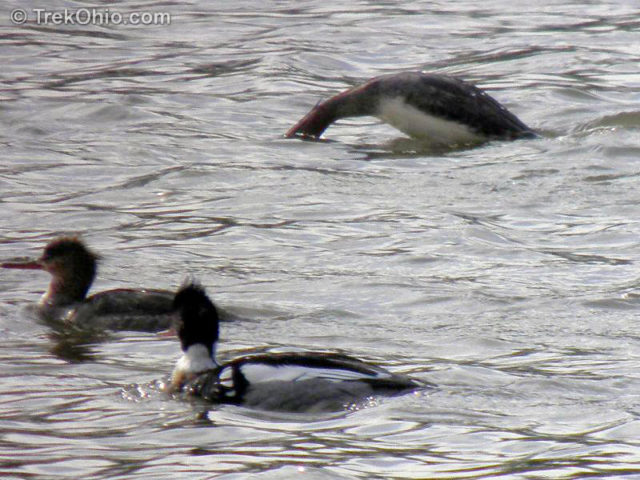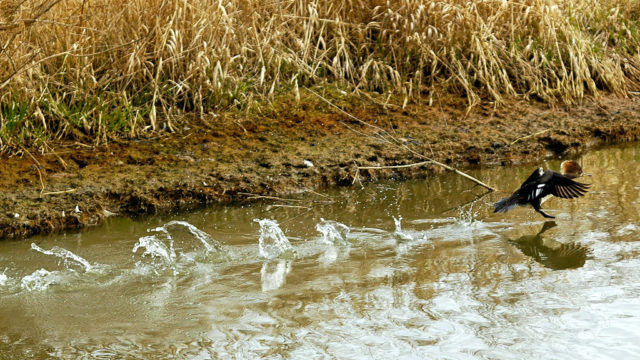Duck species are typically divided into dabblers and divers. Dabblers feed on vegetation and invertebrates that are on or near the surface of the water, while divers swim beneath the water in pursuit of invertebrates and fish.



Dabblers also differ from divers with respect to the location of their legs. A dabbler’s legs are positioned in the middle of the duck’s underside. When they are dabbling upside-down , they can use their feet to stabilize their bobbing. With their legs directly below the center of their mass, dabblers have good balance while walking and wading. In contrast the legs of divers are off-center and positioned closer to the rear of their bodies. This disadvantages divers when walking, but it enhances their ability to dive and to swim underwater.


Illustration of a diving bird, the Red-breasted Merganser. Note how the legs are located much closer to the rear of its body.

Most diving ducks subsist off of underwater invertebrates, like snails and insects. But Mergansers prefer fish.

In addition to differently positioned legs, dabblers and divers also have different wing size. Dabblers have longer, tapered wings, while divers have shorter, stubbier wings. The shorter wings reduce the amount of drag that divers experience while underwater. However this combination of wing and leg differences means that dabblers and divers must use different techniques to launch themselves into the air. Usually dabblers can become airborne almost immediately by pushing both feet down while beating their wings. Divers typically have to run or hop across the surface of the water while beating their wings as they try to reach “lift velocity.”

Mallard just after launching itself into the air in a single move.

Hooded Merganser hops across the surface of the water while attempting to take off.
While swimming along the surface of the water, dabbling ducks typically float high in the water. In contrast diving ducks often float low in the water with just their heads and the top of their backs exposed to air.


After doing a DNA analysis on members of these two classes of ducks, scientists learned that dabblers and divers are not that closely related. Although they look similar, we now believe that’s because they have adapted to similar habitats.
Although the lists below are not exhaustive, here are some examples of dabblers and divers that are found in Ohio.
Ohio dabbling ducks include:
- American Black Duck
- American Wigeon
- Blue-winged Teal
- Gadwall
- Green-winged Teal
- Mallard
- Northern Pintail
- Northern Shoveler
- Wood Duck
Ohio diving ducks include:
- Canvasback
- Hooded Merganser
- Lesser Scaup
- Pied-billed Grebe
- Red-breasted Merganser
- Redhead
- Ring-necked Duck
- Ruddy Duck
Despite the differences described above, you will occasionally see a dabbler diving completely underwater… you know, just to confuse things. ![]() To un-confuse things, I have summarized the key differences below.
To un-confuse things, I have summarized the key differences below.
Summary
| Dabblers | Divers | |
|---|---|---|
| Food | Vegetation, plus invertebrates | Invertebrates and fish |
| Habitat | Shallow water | Deeper water |
| Swimming | Floats high in the water | Floats low in the water |
| Legs | Centered on body’s underside | Offset toward the bird’s rear |
| Wings | Long | Stubby |
| Becoming airborne | Launch themselves almost immediately | Must run/hop for some distance while beating wings. |
Additional information
- ODNR: Waterbirds of Ohio (PDF)
- Wikipedia: Anatinae – the subfamily of waterfowl that feeds by dabbling
- Wikipedia: Diving duck
- Wikipedia: Perching duck
- Essay at Stanford: Dabblers vs. Divers
- San Diego Zoo: Dabbling vs Diving Ducks

It took me years to get to grips with Canadian duck ID. They’re challenging subjects in poor light on large grey lakes. Nice guide! 🙂
What a wonderful and educational overview, with fantastic images! I love our dabbling ducks. I have hundreds…no joke…of images of ’em. 🙂
Fantastic comparison post, Deb, thanks for sharing! And Happy New Year to you and Bob!
good job